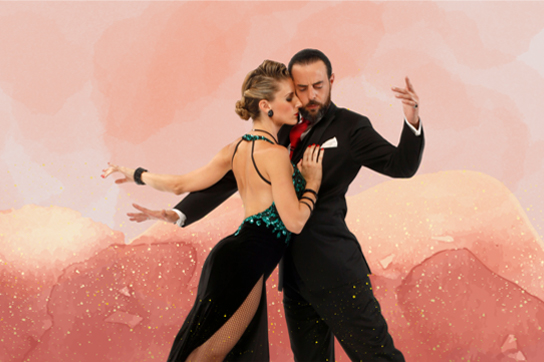
Saturday, 06 July 2024 : 12h45-17h45
[ATTENTION: Due to the use of the salle Osète as a polling station for the elections, the venue and timetable for the maestros courses have been changed. Please note these changes, indicated in red below!
Thank you for your understanding.]
8 workshops devoted to musical interpretation with maestros Rodrigo Rufino & Gisela Passi! ¡No te lo pierdas!
Organised by our partner Tangueando Toulouse.
FRIDAY 5th JULY - "Dancing the instruments" [moved to salle San Subra]
Workshop 1 • 2.30pm-4pm: "Dancing the violins"
Discover the melodic and rhythmic role of each instrument in a typical tango orchestra, solo and collective roles, solo, solo tutti. Violins and violas.
Orchestras studied: Carlos di Sarli, Osvaldo Pugliese
Aims: To develop dance steps that match the particularities of violins.
Using a very specific selection of music and recordings specially made for the course, enable the students to develop the body language and vocabulary appropriate to the dance floor. What tango figures correspond to the phrasing of the violins?
Expected benefits for the student at the end of the course: Distinguish the musical layers, create a dance vocabulary adapted to the lyrical or rhythmic nuances of the violins, develop knowledge of orchestras.
All levels
Workshop 2 • 4.15pm-5.45pm: "Dancing the double bass"
Discovering the specific roles of the double bass in a typical orchestra.Times and tempos, different marcatos and syncopations.
Orchestras studied: Juan d'Arienzo, Francisco Canaro, Carlos di Sarli, Osvaldo Pugliese
Aims: Using a very specific selection of music and recordings specially made for the course, find the dance steps to express the different functions of the double bass. The "pisada" or footwork, the energies of walking on the rhythmic markings of the tango.
Benefits expected for the student at the end of the course: Rhythmic awareness within the figures, dance vocabulary in the density of the double bass, differentiate the effects of the double basses in the orchestras proposed.
Level: beginner / intermediate
Workshop 3 • 6pm-7.30pm: "Dancing the bandoneon"
Which dance steps are conducive to fraseo ("phrasing")? Particular attention will be paid to bandoneon solos.
Orchestras studied: Aníbal Troilo, Pedro Laurenz and others
Aims: Using a very specific musical selection and recordings specially made for the course, develop technique and dance steps in keeping with the particularities of the bandoneon. The emphasis will be on solos.
Expected benefits for the student at the end of the course: Know how to dance on a single instrument, in turn. Master the woman's adornos, slowing down, speeding up and breathing for the couple.
Level: intermediate / advanced
SATURDAY 6th JULY - "Tango and waltz rhythms"
Workshop 4 • 12.45pm-2.15pm: "Dancing the piano"
Using a very specific selection of music and recordings specially made for the workshop, distinguish the piano, the musical embellishments and the leading role.
Orchestras studied: Carlos di Sarli, Juan d'Arienzo, Rodolfo Biagi, Aníbal Troilo
Aims: To interpret in dance the different roles of the piano in tango. A proposal of leader's steps and follower's embellishments.
Expected benefits for the student : The quality of movement of the feet, the couple's dialogue with the piano, distinguishing bridges or connectors.
Level: beginner / intermediate
Workshop 5 - 2.30pm-4pm: "Dancing syncopations"
Using a very specific selection of music and recordings specially made for the workshop, find the technique and dance figures that go with the rhythmic alternations of marcatos and syncopations performed by all the instruments in the orquesta típica.
Orchestras studied: Carlos di Sarli, Juan d'Arienzo, Osvaldo Pugliese, Aníbal Troilo
Aims: Distinguish and interpret syncopations, make syncopated dance steps, individual syncopations and those of the couple. Work on footwork.
Expected benefits for the student at the end of the course: To be able to spot syncopations and master the body language needed to interpret them. Know the appropriate figures and how to syncopate dance in general.
Level: beginner / intermediate
Workshop 6 • 4.15pm-5.45pm: "The rhythmic steps of the Argentine waltz"
Three suggested steps for dancing Argentine waltz and milonga on the dance floor, based on musical phrases. Footwork and speed.
Orchestras studied: Ricardo Tanturi, Alfredo de Angelis, Rodolfo Biagi, Juan d'Arienzo, Francisco Canaro
Aims: The 3 beat measure and the variations in percussive interpretation. Distinguish between musical phrases, and vary the vocabulary between two phrases.
Expected benefits for the student at the end of the course: Distinguish between waltz rhythm and melody. Incorporate rhythmic vocabulary for the ball. Energise or slow down the dance according to the music.
Level: intermediate / advanced
SUNDAY 7th JULY: "The musical dialogue of the legs"
Workshop 7 • 2.30pm-4pm: "The melodic steps of the Argentine waltz"
The rhythmic and melodic alternation in the waltz invites us to vary the repertoire, with three suggested steps for dancing the lyrical passages of the Argentine waltz.
Orchestras studied: Miguel Caló, Carlos di Sarli, Lucio Demare, Aníbal Troilo, Francisco Canaro
Aims: Breathing, slowing down and suspending the dance, then revitalising it. Changing speeds. Distinguishing phrases.
Expected benefits for the student at the end of the course: Knowing how to find musical breaths within a lively piece of music. Knowing and mastering melodic leg patterns.
Level: intermediate / advanced
Workshop 8 • 4.15pm-5.45pm: "Milonga: double role play, mirroring each other"
The milonga as a playful and interactive dance, the couple's dialogue in three step proposals.
Orchestras studied: Edgardo Donato, Francisco Canaro, Juan D'Arienzo
Aims: To give or receive movement, energy and speed. To find a clearer channel of communication through music.
Expected benefits for the trainee at the end of the course : Make both roles active. Exploit the musical characteristics of the milonga. Master the technique of speed and small steps.
Level: intermediate / advanced
Location Chapelle Saint-Michel
18 Grande Rue Saint-Michel
31400 - Toulouse
Accès en transports :
métro Saint-Michel-Marcel-Langer (ligne B)